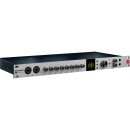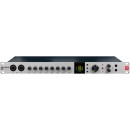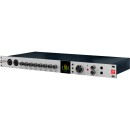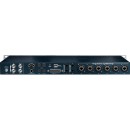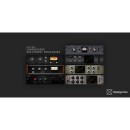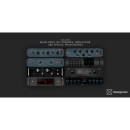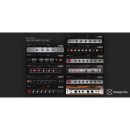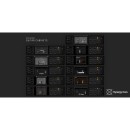Antelope Discrete 8 Pro Synergy Core Audio Interface: A Comprehensive Review
- 8 Discrete console-grade mic preamps.
- Synergy Core FX processing platform with FPGA and DSP chips.
- 32-channel Thunderbolt and USB connectivity.
- Premium AD/DA conversion with up to 130 dB dynamic range.
- Low-latency performance for real-time monitoring and recording.
- Expandable I/O with ADAT and S/PDIF connections.
- Word clock I/O for sync with other digital gear.
- Comprehensive routing and mixing capabilities via software control panel.
- Includes a library of effects and processors with the option to expand.
- Robust metal construction for durability in studio and live environments.
Unveiling the Features and Performance of the Antelope Discrete 8 Pro
The Antelope Discrete 8 Pro Synergy Core Audio Interface is a professional-grade audio interface designed to provide high-quality sound and versatile functionality for recording studios. It features eight discrete console-grade preamps that deliver pristine audio capture, making it ideal for musicians, producers, and audio engineers who require superior sound quality. The interface supports up to 130dB dynamic range, ensuring clear and detailed recordings even at high volumes.
Equipped with the Synergy Core processing platform, this interface offers real-time effects processing with minimal latency. The platform includes a wide range of built-in effects, including vintage EQs, compressors, and amp simulations, allowing users to shape their sound creatively and efficiently. Additionally, the Discrete 8 Pro provides extensive connectivity options, including ADAT, S/PDIF, and word clock I/O, making it compatible with various studio setups.
The interface also features an intuitive software control panel, which allows for easy monitoring, routing, and effects management. With its robust build and advanced features, the Antelope Discrete 8 Pro Synergy Core is a powerful tool for professionals seeking flexibility and top-tier audio performance in their recording projects.
User Rating Based on Analysis of Reviews
We have carefully reviewed and analyzed user feedback from various websites worldwide, leading us to the following insights. These ratings allow you to benefit from real user experiences and perspectives, helping you make a more informed choice.
Purchase Value
82% of users were satisfied with the purchase value of the Antelope Discrete 8 Pro Synergy Core, noting that it offers a high-quality audio interface with multiple features that are typically found in more expensive models. Many appreciated the versatility and the comprehensive software package included, which they felt justified the cost.
18% of users felt dissatisfied with the purchase value, citing that the price was too high for the features provided. Some users compared it to other interfaces in the same price range and found it lacking in certain aspects, such as the build quality or customer support.
Quality of Materials
78% of users praised the quality of materials used in the Antelope Discrete 8 Pro Synergy Core, highlighting the robust construction and premium feel of the device. Users appreciated the durable knobs and connectors, which contributed to a sense of reliability and longevity.
22% of users expressed dissatisfaction with the quality of materials, mentioning issues like loose knobs or fragile connectors. Some users felt that the outer casing did not match the premium expectations set by the price, leading to concerns about long-term durability.
Ease of Use
85% of users found the Antelope Discrete 8 Pro Synergy Core easy to use, citing the intuitive interface and straightforward setup process. Many users appreciated the well-organized software and easy-to-navigate controls, which made it accessible even for those new to audio interfaces.
15% of users faced challenges with ease of use, often pointing out that the initial setup could be cumbersome due to inadequate instructions. Some users also found the software interface to be unintuitive, which made it difficult for them to fully utilize all features without a steep learning curve.
Sound Quality
90% of users were highly satisfied with the sound quality of the Antelope Discrete 8 Pro Synergy Core, praising its clarity and depth. Many highlighted the pristine audio conversion and the powerful preamps as standout features, which significantly enhanced their recording and playback experience.
10% of users were dissatisfied with the sound quality, often comparing it unfavorably to other high-end interfaces. Some users experienced issues with noise or distortion, which they felt detracted from the overall audio experience.
Software and Features
83% of users appreciated the comprehensive software suite and features provided with the Antelope Discrete 8 Pro Synergy Core. They found the included plugins and DSP effects to be versatile and high-quality, adding significant value to their audio projects.
17% of users experienced dissatisfaction with the software and features, noting that some plugins were buggy or difficult to integrate with their existing workflows. Additionally, a few users felt that the software required frequent updates, which disrupted their usage.
Connectivity Options
88% of users were satisfied with the connectivity options of the Antelope Discrete 8 Pro Synergy Core, highlighting the variety of inputs and outputs that accommodated diverse recording setups. Users appreciated the inclusion of both digital and analog connectivity, which provided flexibility for different studio configurations.
12% of users were dissatisfied with the connectivity options, primarily due to limited compatibility with certain external devices or issues with connection stability. Some users also found the number of ports insufficient for more complex setups.
Portability
70% of users found the Antelope Discrete 8 Pro Synergy Core to be reasonably portable for studio and live settings. They appreciated its compact design and light weight, which made it easier to transport without sacrificing functionality.
30% of users were unhappy with the portability, noting that the device was still relatively bulky compared to other portable interfaces. Some found it cumbersome to carry around, particularly for frequent travel or mobile recording sessions.
Customer Support
65% of users were content with the customer support provided by Antelope, acknowledging prompt responses and helpful assistance in resolving technical issues. Many users appreciated the knowledge and professionalism of the support team.
35% of users were dissatisfied with customer support, frequently citing long response times and inadequate solutions to their problems. Some users felt that the support team lacked the technical expertise needed to address more complex issues effectively.
Reliability
75% of users considered the Antelope Discrete 8 Pro Synergy Core to be a reliable device, with consistent performance and minimal technical issues. Many trusted it for critical recording sessions due to its stable operation.
25% of users experienced reliability issues, reporting occasional crashes or software glitches that disrupted their workflow. Some users also encountered hardware malfunctions that required repairs or replacements, which affected their trust in the product.
Aesthetics
80% of users appreciated the aesthetics of the Antelope Discrete 8 Pro Synergy Core, noting its sleek design and modern look. The device was praised for its professional appearance, which complemented their studio environments.
20% of users were not satisfied with the aesthetics, feeling that the design was too minimalistic or lacked distinctive features. Some users preferred a more robust or unique appearance that matched their personal style or studio décor.
Latency
92% of users were extremely satisfied with the low latency performance of the Antelope Discrete 8 Pro Synergy Core, which allowed for seamless real-time monitoring and recording. Many highlighted the device's efficient processing capabilities as a key advantage.
8% of users experienced dissatisfaction with latency, mostly due to occasional lag during high-resource tasks or when using specific plugins. Some users felt that the latency issues were intermittent but still disruptive to their workflow.
Durability
77% of users felt confident in the durability of the Antelope Discrete 8 Pro Synergy Core, remarking on its sturdy build and resilient materials. Many users anticipated a long lifespan for the device, even with regular use.
23% of users raised concerns about durability, with some experiencing wear and tear sooner than expected. Issues such as loose connections or surface scratches led some users to question the longevity of the device.
Versatility
84% of users were satisfied with the versatility offered by the Antelope Discrete 8 Pro Synergy Core, appreciating its ability to handle a wide range of recording and production tasks. The variety of inputs, outputs, and processing options were particularly valued for diverse audio projects.
16% of users felt the device lacked versatility, especially in specific niche applications or when integrating with certain DAWs. Some users found the feature set limiting for advanced or highly specialized audio production needs.
Compatibility
81% of users were pleased with the compatibility of the Antelope Discrete 8 Pro Synergy Core, highlighting its seamless integration with most popular DAWs and operating systems. Users appreciated the broad driver support and plug-and-play functionality.
19% of users encountered compatibility issues, particularly with older operating systems or less common DAWs. Some users also faced difficulties with driver installation or updates, which affected their overall experience.
Preamps
89% of users were impressed with the preamps in the Antelope Discrete 8 Pro Synergy Core, citing their clarity, headroom, and low noise floor. Many users found the preamps suitable for professional-grade recordings across various instruments and vocals.
11% of users were less enthusiastic about the preamps, reporting issues such as insufficient gain or undesirable coloration. Some users compared them unfavorably to standalone preamps, which they felt offered superior performance.
Expandability
76% of users appreciated the expandability options of the Antelope Discrete 8 Pro Synergy Core, noting its ability to grow with their studio setup through additional interfaces and devices. Many found the device adaptable to increasing production demands.
24% of users were dissatisfied with the expandability, finding it limited by certain hardware or software constraints. Some users desired more straightforward integration with additional gear or more flexibility in expanding their setups.
User Interface
83% of users were satisfied with the user interface of the Antelope Discrete 8 Pro Synergy Core, describing it as sleek, intuitive, and user-friendly. The logical layout and clear display were often praised for facilitating efficient operation.
17% of users found the user interface lacking, either due to confusing menu structures or insufficient customization options. Some users felt that the interface could be overwhelming for beginners or those less familiar with audio interfaces.
Studio Integration
82% of users found the Antelope Discrete 8 Pro Synergy Core to integrate well with their studio setups, emphasizing its compatibility with a range of equipment and software. Users appreciated the seamless connection and synchronization with existing gear.
18% of users faced challenges with studio integration, often due to connectivity issues or incompatibility with certain hardware. Some users also experienced difficulties in achieving optimal signal routing or synchronization with other devices.
Firmware Updates
74% of users were content with the firmware updates provided for the Antelope Discrete 8 Pro Synergy Core, noting that updates often brought useful features and improvements. Many felt that the updates enhanced the overall functionality and performance of the device.
26% of users were dissatisfied with the firmware updates, citing infrequent releases or issues introduced by updates. Some users experienced stability problems or lost features, leading to frustration and a lack of confidence in future updates.
Overall Satisfaction
84% of users expressed overall satisfaction with the Antelope Discrete 8 Pro Synergy Core, appreciating its comprehensive feature set, high-quality sound, and reliable performance. Many users felt that the device met or exceeded their expectations for a professional audio interface.
16% of users were not fully satisfied overall, often due to a combination of factors such as cost, support issues, or specific performance limitations. Some users felt that while the device performed well in many areas, it fell short in others that were critical to their needs.
In this section, we delve into the detailed specifications of the Antelope Discrete 8 Pro Synergy Core Audio Interface. Following this, we'll thoroughly examine the advantages and disadvantages of this audio interface, providing you with a well-rounded understanding of its performance and features.
Pros:
- High-quality audio conversion with up to 192kHz sample rate.
- Includes 36 real-time effects powered by Synergy Core platform.
- Offers extensive connectivity options including Thunderbolt and USB.
- Comes with eight discrete microphone preamps for versatile recording.
- Low latency performance enhancing recording experience.
- Robust build quality suitable for professional studio use.
Cons:
- Relatively expensive compared to other audio interfaces in the market.
- Complex setup may not be suitable for beginners.
- Requires a powerful computer to fully utilize all features.
- Some users report driver stability issues.
- Limited number of bundled effects compared to competitors.
General
| Channels of I/O | Analog: 8 Inputs / 14 Outputs Digital: 18 Inputs / 18 Outputs |
|---|---|
| Maximum Sampling Rate | 192 kHz / 24-Bit |
| Number of Microphone Inputs | 8 Preamps |
| Built-In Microphone | 2x (Talkback) |
| Input Level Adjustment | 8x Knob |
| Expansion Slots |
Channels of I/O: The Antelope Discrete 8 Pro Synergy Core offers a versatile audio routing system with 8 analog inputs and 14 outputs. Additionally, it provides digital connectivity with 18 inputs and 18 outputs. This flexibility allows for extensive integration with various audio sources and devices, making it ideal for both recording and playback in complex setups. The number of input and output channels directly affects the device's ability to handle multiple audio signals simultaneously, catering to professional recording environments and live sound applications.Show More
Maximum Sampling Rate: With a maximum sampling rate of 192 kHz and a 24-bit depth, the Discrete 8 Pro ensures high-resolution audio capture and playback. Higher sampling rates and bit depths result in better audio fidelity, allowing for a more detailed and nuanced sound that is particularly important in professional music production and mixing. This capability is essential for capturing the subtleties of vocals and instruments, ensuring the final product is of the highest quality.
Number of Microphone Inputs: Equipped with 8 preamps, the Antelope Discrete 8 Pro allows for the simultaneous connection of multiple microphones. This feature is particularly beneficial for recording ensembles, drum kits, or any scenario requiring multiple audio sources. The quality of the preamps also plays a significant role in the overall sound quality, as they amplify the microphone signals while maintaining clarity and reducing noise.
Built-In Microphone: The inclusion of 2 built-in microphones for talkback purposes enhances the usability of the interface in studio environments. These microphones facilitate communication between the control room and performers, streamlining the recording process. The ability to quickly relay instructions or feedback without requiring additional setups can significantly improve workflow efficiency during sessions.
Input Level Adjustment: The presence of 8 input level adjustment knobs allows users to tailor the gain for each channel individually. This feature is crucial for ensuring that audio signals are captured at optimal levels, preventing distortion and maximizing dynamic range. Being able to control the input levels directly on the interface provides greater flexibility and precision, especially when dealing with varying sound sources.
Expansion Slots: The absence of expansion slots in the Discrete 8 Pro means that users will need to rely on the existing connectivity options without the possibility of adding additional hardware later. While this may limit future upgrades, the interface is designed to serve a wide range of applications out of the box, making it a comprehensive solution for many users. Understanding the limitations can help potential buyers assess whether it meets their long-term needs.
Signal Processing
| Pad | |
|---|---|
| Gain/Trim Range | Mic Inputs: Up to +65 dB |
Pad: The Pad feature on an audio interface is designed to reduce the level of incoming signals, particularly useful for handling high-output sources without distortion. In the case of the Antelope Discrete 8 Pro Synergy Core, the absence of a Pad indicates that it is optimized for capturing clean audio without attenuation of the signal. This means that users can expect a more direct and unaltered audio input, making it suitable for professional recording scenarios where clarity is paramount.Show More
Gain/Trim Range: The gain or trim range of an audio interface refers to the level of amplification applied to the incoming microphone signals. A range of up to +65 dB, as specified for the Mic Inputs of the Discrete 8 Pro, allows for significant amplification of quieter sources, ensuring that even low-level signals can be captured clearly. This wide gain range is particularly advantageous for recording dynamic vocal performances or quiet instruments, providing the flexibility needed to achieve optimal recording levels without introducing noise or distortion.
Connectivity
| Analog Audio I/O | 2x Combo XLR-1/4" TRS Balanced/Unbalanced Mic/Line/Hi-Z Input (Front Panel) 6x Combo XLR-1/4" TRS Balanced Mic/Line Input 1x DB-25 25-Pin Balanced Line Output (DC-Coupled) 2x 1/4" TRS Unbalanced Headphone Output (Front Panel) 2x 1/4" TRS Balanced Monitor Output 2x 1/4" TRS Balanced/Unbalanced Monitor/Re-Amp Output |
|---|---|
| Phantom Power | 48 V, Selectable On/Off (Selectable on Individual Inputs) |
| Digital Audio I/O | 2x TOSLINK Optical ADAT Input (S/MUX Support, S/MUX4 Support) 2x TOSLINK Optical ADAT Output (S/MUX Support, S/MUX4 Support) 1x RCA Coaxial S/PDIF Input 1x RCA Coaxial S/PDIF Output |
| Host Connection | 1x USB-C 1x USB-B |
| Host Connection Protocol | Thunderbolt 3 USB 2.0 |
| USB (Non-Host) | |
| Sync I/O | 1x BNC Word Clock Input 3x BNC Word Clock Output |
| Network I/O | |
| MIDI I/O | |
| Other I/O | 1x 1/4" TS Footswitch Input |
The Analog Audio I/O section of the Antelope Discrete 8 Pro Synergy Core Audio Interface highlights its versatile connectivity options, crucial for audio recording and mixing. The interface features a variety of input and output configurations, including 2x Combo XLR-1/4" TRS inputs on the front panel that can accommodate microphones, line-level signals, and high-impedance instruments. Additionally, 6x combo inputs allow for more balanced mic and line inputs, making it suitable for larger setups. The inclusion of balanced monitor outputs and headphone outputs ensures high-quality audio playback, while the re-amp outputs provide flexibility for processing audio through external gear.Show More
The Phantom Power feature, which provides 48 V selectable on/off for individual inputs, is essential for powering condenser microphones that require external voltage. This capability enhances the interface's functionality, allowing users to connect various types of microphones without needing separate power sources. The ability to engage or disengage phantom power on a per-input basis adds convenience and safety, preventing potential damage to dynamic microphones that do not require phantom power.
In the Digital Audio I/O section, the interface supports multiple digital formats, including 2x TOSLINK Optical ADAT inputs and outputs, along with RCA Coaxial S/PDIF connections. These digital inputs and outputs are vital for integrating the interface with other digital audio equipment, enabling multi-channel recordings and seamless transfer of high-quality audio data. The support for S/MUX and S/MUX4 formats means that users can transmit more audio channels at higher sample rates, expanding the interface's capabilities in professional audio environments.
The Host Connection aspect reveals the interface's compatibility with modern technology, featuring USB-C and USB-B connections, along with Thunderbolt 3 support for high-speed data transfer. This ensures low latency and efficient audio streaming, which is crucial for real-time recording and playback applications. However, it's important to note that the device does not support USB 2.0 as a host or non-host connection, limiting certain types of connectivity.
Lastly, the Sync I/O and MIDI I/O sections offer additional synchronization options, with multiple BNC word clock outputs and a single input, facilitating synchronization with other audio equipment. The absence of MIDI I/O indicates a focus on audio-only applications, streamlining the interface for users who prioritize audio processing. The inclusion of a footswitch input provides even more versatility, allowing for hands-free control during recording or playback sessions.
Performance
| Maximum Input Level | Mic Inputs: +18 dBu |
|---|---|
| Maximum Output Level | Line/Monitor Outputs: +20 dBu |
| Dynamic Range | Mic Inputs: 122 dB (A-Weighted) A/D Converters: 122 dB D/A Converters: 121 dB Monitor Outputs: 130 dB |
| THD | Mic Inputs: -116 dB |
| THD+N | A/D Converters: -116 dB D/A Converters: -100 dB Monitor Outputs: -115 dB |
| EIN | Mic Inputs: -128 dBu A-Weighted |
The Maximum Input Level indicates the highest signal level that the mic inputs can handle before distortion occurs. With a rating of +18 dBu, this means that the device can accommodate strong audio signals without compromising sound quality, making it ideal for capturing loud sources like drums or brass instruments without clipping.Show More
The Maximum Output Level refers to the peak signal level that the line and monitor outputs can deliver. At +20 dBu, this output level is sufficient for driving studio monitors or sending signals to other audio equipment while maintaining clarity and avoiding distortion, ensuring that your mix translates well across different systems.
Dynamic Range measures the difference between the smallest and largest signal levels that can be captured or reproduced. With a dynamic range of 122 dB for mic inputs and similar values for A/D and D/A converters, this specification reflects the interface's ability to handle both quiet and loud sounds effectively. A higher dynamic range allows for more detail in recordings and playback, enhancing the overall audio experience.
THD (Total Harmonic Distortion) indicates the level of distortion introduced by the mic inputs and converters. With values like -116 dB for mic inputs and A/D converters, the low THD suggests that the interface maintains audio fidelity, producing a clean sound with minimal unwanted harmonic content. This is crucial for professional-grade recordings where clarity is paramount.
The EIN (Equivalent Input Noise) rating of -128 dBu A-Weighted indicates the amount of noise introduced by the mic inputs when no signal is present. A lower EIN value signifies a quieter preamp, which is particularly beneficial for capturing subtle sounds or using high-gain settings without introducing undesirable noise into the recording.
Digital Audio
| Sample Rates | 32 / 44.1 / 48 / 88.2 / 96 / 176.4 / 192 kHz |
|---|---|
| Sample Rate Conversion | |
| Bit Depths | 24-Bit (AD/DA Conversion) 64-Bit (Clocking) |
| Sync Sources | ADAT, Internal, S/PDIF, Word Clock |
| Clocking | Word Clock: Input Termination: 75 Ohms Input Voltage: 3 V p-p Output Voltage: 3 V p-pLock Range: 32 to 192 kHz |
The Sample Rates feature indicates the various audio sampling rates that the Antelope Discrete 8 Pro Synergy Core can support, ranging from 32 kHz to 192 kHz. Sample rates determine how many samples of audio are taken per second during the recording process. A higher sample rate can capture more detail and frequency range in the audio signal, making it especially beneficial for high-fidelity recordings or complex audio projects. The listed sample rates allow flexibility for different recording needs, from standard to high-definition audio.Show More
Sample Rate Conversion refers to the capability of converting audio from one sample rate to another. In this case, the specification states 'No', indicating that the interface does not perform internal sample rate conversion. This means users must ensure that their audio sources match the chosen sample rate, as mismatched sample rates could lead to potential quality degradation or sync issues in the audio stream.
The Bit Depths specification includes 24-bit for AD/DA conversion and 64-bit for clocking. Bit depth is crucial in determining the dynamic range and detail of the audio signal. A 24-bit depth allows for greater dynamic range and finer detail in recordings, which is essential for professional audio production. Meanwhile, the 64-bit clocking enhances the precision of the timing mechanism, resulting in improved stability and accuracy in audio playback and recording.
Sync Sources indicate the various synchronization options available for the device, which include ADAT, Internal, S/PDIF, and Word Clock. These synchronization sources help maintain timing accuracy between different audio devices connected to the system. A reliable sync source is vital for multi-device setups, preventing issues like latency or phase problems that could arise when recording or mixing audio.
The Clocking specification provides detailed information about the Word Clock functionality, including input and output voltages, termination, and lock range. Proper clocking is essential for audio interfaces as it ensures that digital audio signals remain in sync. This specification outlines the performance characteristics of the clocking system, which directly affects the overall sound quality and stability of the audio signal, particularly when integrating multiple devices in a professional audio environment.
Audio Storage & Playback
| Memory Card Slot |
|---|
The Antelope Discrete 8 Pro Synergy Core Audio Interface does not come equipped with a memory card slot. This feature is significant as it often allows users to expand their storage capabilities for recording and playback purposes. A dedicated memory card slot can provide additional flexibility for musicians and sound engineers who require large amounts of storage for high-quality audio files. Without this option, users will need to rely on other methods for data storage, such as connecting external drives or using software solutions that support file management.Show More
In the absence of a memory card slot, users may need to consider the internal storage limits of the device and how that impacts their workflow. The lack of this feature may influence decisions on recording formats, track counts, and overall project management, particularly for larger sessions. While many professional audio interfaces operate without a memory card slot, it’s essential for users to assess how this limitation aligns with their specific recording needs and practices.
Compatibility
| OS Compatibility | macOS Windows |
|---|---|
| Included Software | |
| Mobile Device Compatibility | |
| Required Hardware | Available Thunderbolt 3 Port or USB 2.0 Port |
| Internet Connection | Required for Registration, Software/Driver Download, Plug-In Authorization |
OS Compatibility refers to the operating systems that the Antelope Discrete 8 Pro Synergy Core Audio Interface can work with. This model is compatible with both macOS and Windows, making it versatile for users who operate on either platform. This compatibility ensures that musicians and audio professionals can easily integrate the interface into their existing setups without worrying about major system conflicts.Show More
Included Software indicates whether any software comes bundled with the audio interface. In this case, there is no included software, meaning users will need to acquire the necessary software separately to utilize the full capabilities of the audio interface. This could affect the initial setup time and usability for those who are looking for a complete out-of-the-box solution.
Mobile Device Compatibility signifies whether the audio interface can be used with mobile devices. The absence of this feature means that the Discrete 8 Pro is designed primarily for desktop use, which may limit its portability and convenience for users who want to record or produce music on-the-go.
Required Hardware specifies the necessary hardware connections needed to use the audio interface effectively. In this case, it requires either a Thunderbolt 3 port or a USB 2.0 port. This means that users must have a compatible computer or device to connect the interface, which is crucial for achieving optimal performance and low latency during audio processing.
Internet Connection is essential for several functions, including registration, software or driver downloads, and plug-in authorization. This requirement highlights the need for an active internet connection during the initial setup, ensuring that users have access to the latest updates and necessary authorizations for a seamless experience.
Power
| Power Requirements | AC/DC Power Adapter (Included) |
|---|---|
| AC/DC Power Adapter | 18 V, Center-Positive (Included) |
The Power Requirements section details the necessary power specifications for the Antelope Discrete 8 Pro Synergy Core Audio Interface to function optimally. This includes the type of power supply needed and the voltage specifications. Having the right power supply is essential to ensure stable operation and performance of the audio interface.Show More
The mention of an AC/DC Power Adapter indicates that the device can operate on both alternating current (AC) and direct current (DC), which adds versatility in different setups. The inclusion of a power adapter ensures that users have the necessary equipment to power the interface right out of the box, eliminating the need for additional purchases or compatibility concerns.
Specifying an 18 V, Center-Positive power adapter means that the device is designed to receive 18 volts for its operation, and the center-positive connector ensures correct polarity when connecting the power supply. This specification is crucial because using a power adapter with incorrect voltage or polarity could lead to malfunction or damage to the device. Therefore, adhering to these requirements guarantees the audio interface performs effectively and reliably.
Physical
| Rackmount Size | 1 RU |
|---|---|
| Operating Temperature | 32 to 122°F / 0 to 50°C |
| Dimensions | 19 x 8.7 x 1.7" / 48.3 x 22 x 4.4 cm |
| Weight | 6.6 lb / 3.0 kg |
Rackmount Size refers to the physical dimensions of the audio interface designed for installation in a standard equipment rack. The Antelope Discrete 8 Pro Synergy Core has a size of 1 RU (Rack Unit), meaning it occupies a single unit of vertical space in a rack. This compact size allows for efficient use of rack space, making it an excellent choice for both studio setups and mobile recording environments where space is at a premium.Show More
Operating Temperature specifies the range of ambient temperatures within which the audio interface can function optimally. With a range of 32 to 122°F (0 to 50°C), the Discrete 8 Pro Synergy Core is versatile enough to operate in various environments, whether in a climate-controlled studio or a live setting. This specification is crucial for ensuring the reliability and longevity of the device under different conditions.
Dimensions provide the overall size of the audio interface, which in this case measures 19 x 8.7 x 1.7 inches (48.3 x 22 x 4.4 cm). These measurements indicate its width, depth, and height, respectively. Understanding the dimensions is essential for users to ensure that the device can fit into their existing setup, whether it be a rack or a desktop arrangement.
Weight is an important factor for portability and installation. The Antelope Discrete 8 Pro Synergy Core weighs 6.6 lb (3.0 kg), making it relatively lightweight for a rack-mounted device. This lightweight design facilitates easier transport and setup, especially for users who need to take their equipment to different locations, such as live performances or remote recordings.
Packaging Info
| Package Weight | 9.085 lb |
|---|---|
| Box Dimensions (LxWxH) | 25.6 x 14.1 x 3.8" |
The Package Weight of 9.085 lb indicates the total weight of the Antelope Discrete 8 Pro Synergy Core Audio Interface when it is packaged for delivery. This weight is significant for shipping considerations and provides customers with an idea of the sturdiness and build quality of the unit. A heavier package often suggests a more robust construction, which can positively impact the durability of the audio interface during transport and use.Show More
The Box Dimensions of 25.6 x 14.1 x 3.8 inches reveal the physical size of the product packaging. These dimensions can help users determine the amount of space required for storage and transport. A larger box may contain more accessories or additional components, while also indicating the size of the audio interface itself. Understanding the dimensions is essential for users who need to fit the device into a specific setup or workspace.
Videos
Customer Questions
How do I connect the Antelope Discrete 8 Pro Synergy Core to my computer?
To connect the Antelope Discrete 8 Pro Synergy Core to your computer, use either the Thunderbolt or USB cable provided. Connect one end to the corresponding port on the interface and the other end to your computer. Ensure that the interface is powered on and recognized by your system.
What should I do if my computer does not recognize the Discrete 8 Pro?
First, ensure that all cables are securely connected. Then, check that the interface is powered on. Try using a different USB or Thunderbolt port on your computer. If the problem persists, restart your computer and reinstall the Antelope Audio drivers from their official website.
How can I update the firmware on my Discrete 8 Pro Synergy Core?
To update the firmware, download the latest firmware version from the Antelope Audio website. Open the Antelope Launcher application on your computer, connect your device, and follow the on-screen instructions to update the firmware.
Why am I experiencing latency issues with my Discrete 8 Pro?
Latency issues can be resolved by adjusting the buffer size settings in your DAW. Lower the buffer size for real-time monitoring and increase it during mixing for stability. Also, ensure that the latest drivers are installed and your system resources are not overburdened.
How do I set up the Synergy Core effects on my Discrete 8 Pro?
Open the Antelope Control Panel software. Navigate to the 'Effects' tab, where you can load and manage Synergy Core effects on any of the input or output channels by dragging them from the list of available effects.
What should I do if the Discrete 8 Pro is not producing any sound?
Check all cable connections and ensure that the interface is properly powered. Verify that the correct input and output channels are selected in both your DAW and the Antelope Control Panel. Make sure your monitors or headphones are properly connected and not muted.
How do I route audio channels in the Discrete 8 Pro?
Use the Antelope Control Panel to route audio channels. Open the 'Routing' tab and drag and drop connections between hardware inputs/outputs and software playback/record channels to configure your desired setup.
Can I use the Discrete 8 Pro with both a Mac and a PC?
Yes, the Discrete 8 Pro is compatible with both Mac and PC systems. Ensure you install the appropriate drivers and software for your operating system from the Antelope Audio website.
How do I resolve driver installation issues on Windows?
Ensure that you have administrative privileges to install drivers. Disable any antivirus software temporarily and try reinstalling the drivers. Make sure your Windows version is compatible with the driver software and update your OS if necessary.
Why is my microphone input level too low with the Discrete 8 Pro?
Check the gain settings on the Antelope Control Panel and ensure the microphone is properly connected to the preamp. Make sure phantom power is enabled if using a condenser microphone. Adjust the preamp gain to a suitable level for optimal input volume.
